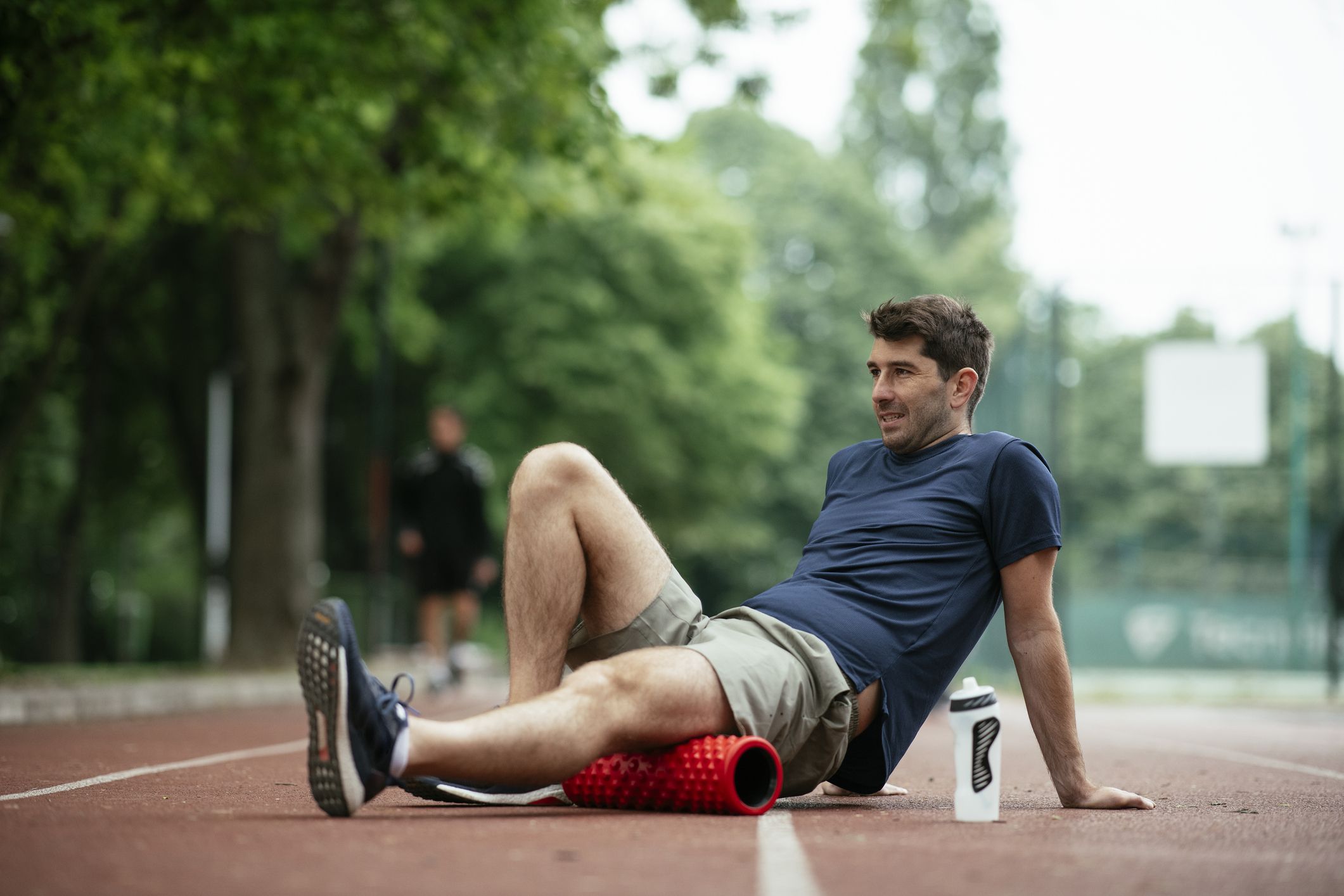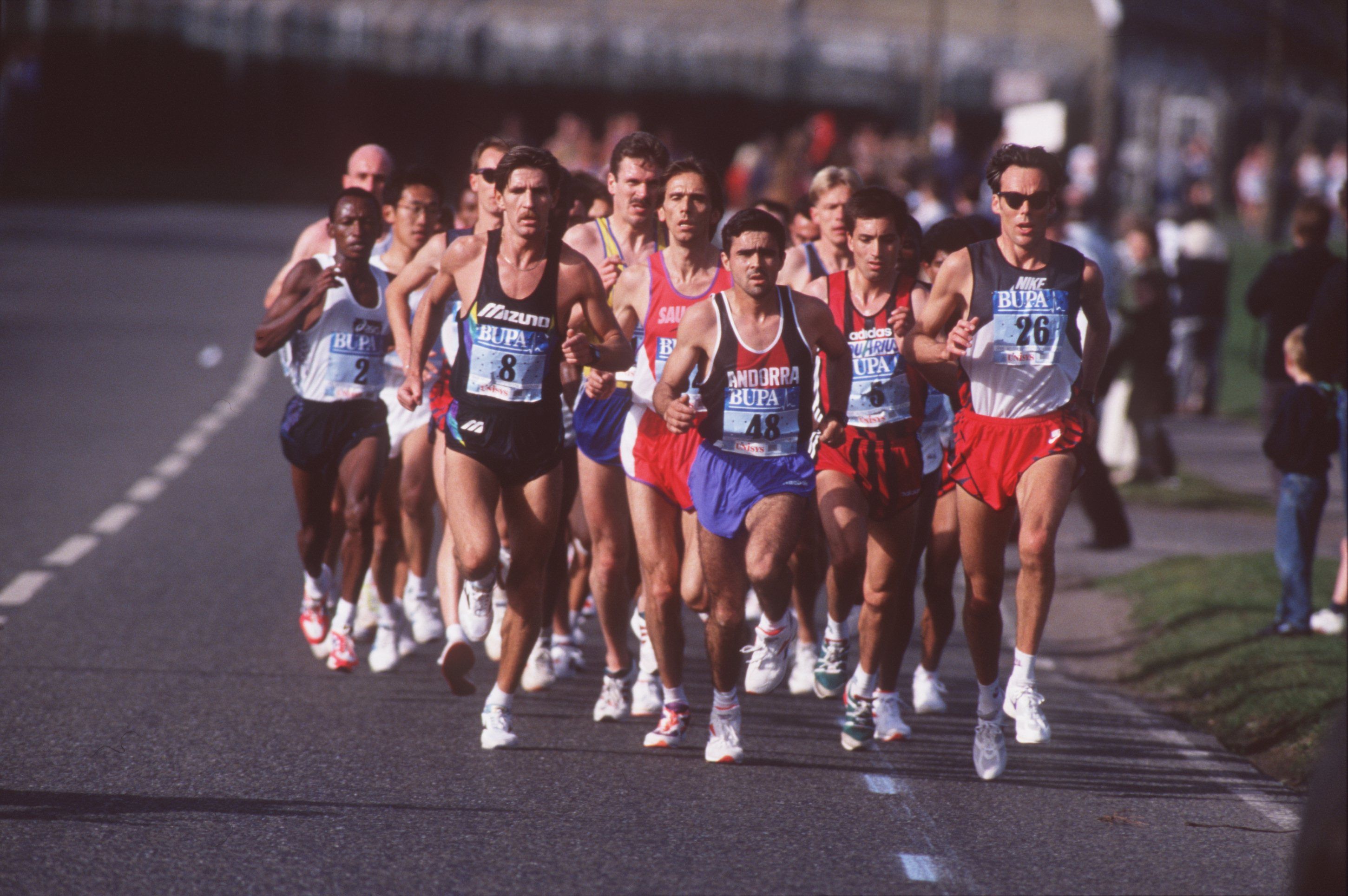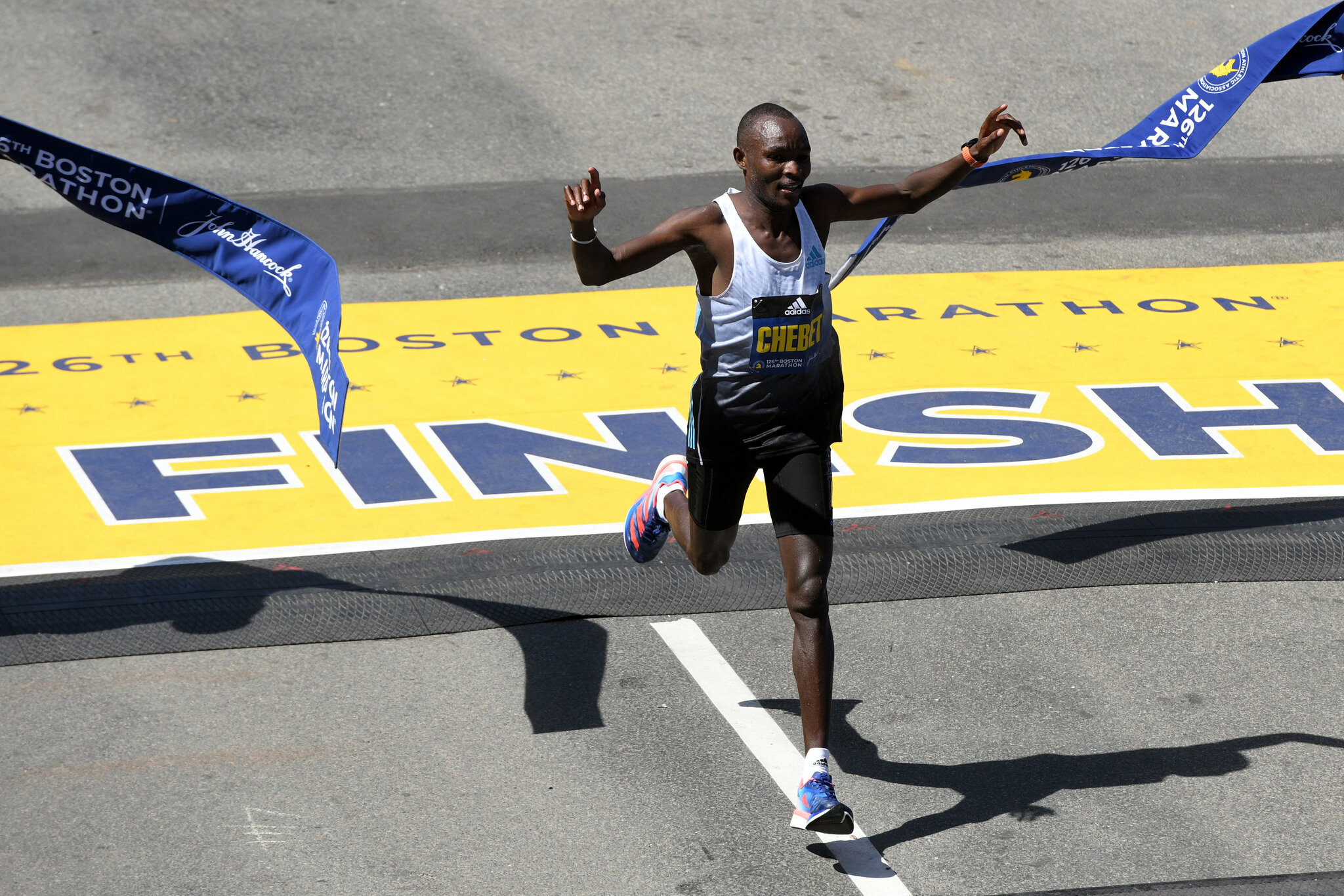

Featured
Why Did The Marathon Runner Collapse
Modified: January 22, 2024
Discover the shocking reasons why the featured marathon runner collapsed and learn how to prevent such incidents in the future. Uncover crucial insights now.
Introduction
Welcome to the thrilling world of marathon running, an endurance sport that pushes the limits of human capabilities. Witnessing athletes conquer incredible distances, it’s easy to be inspired by their determination and commitment. However, alongside the triumphs, we occasionally hear stories of marathon runners collapsing during races, leaving us bewildered and concerned.
So, why do marathon runners collapse? Is it a result of a lack of preparation, or are there other factors at play? In this article, we will explore the various reasons why marathon runners sometimes experience collapses, shedding light on the physical demands of the sport and the potential dangers that can arise.
It’s important to note that collapsing during a marathon is relatively rare, as most runners are well-prepared and take necessary precautions. Nevertheless, understanding the potential causes of collapses can help us appreciate the importance of proper training, nutrition, and race day strategies in preventing such incidents.
To gain a comprehensive understanding of why marathon runners may collapse, we’ll delve into the physical demands of long-distance running and the factors that can contribute to collapses. We’ll also examine the impact of heat stress, dehydration, overexertion, fatigue, and pre-existing medical conditions on a runner’s performance and well-being. Additionally, we’ll explore the role of training, preparation, and environmental factors in ensuring a successful race experience.
By the end of this article, you’ll have a wealth of knowledge to better comprehend the reasons behind marathon collapses and the measures that can be taken to minimize the risk. So, lace up your running shoes and let’s embark on this enlightening journey into the world of marathon running.
Understanding Marathon Running
Marathon running is an iconic sporting event that involves covering a distance of 26.2 miles (42.195 kilometers) in a single race. It is a test of physical and mental endurance, requiring months of dedicated training and preparation. The marathon traces its roots back to ancient Greece, where the legendary messenger Pheidippides ran from the city of Marathon to Athens to deliver news of a military victory.
Today, marathons attract thousands of participants from around the world, ranging from elite athletes aiming for record-breaking times to recreational runners seeking personal achievements. The event is renowned for its electrifying atmosphere, with crowds cheering and encouraging runners every step of the way.
Running a marathon demands a high level of aerobic fitness, as the body needs to efficiently utilize oxygen to sustain prolonged physical exertion. The cardiovascular and respiratory systems work in tandem to supply oxygen to the muscles, allowing them to generate energy and maintain a steady pace. Endurance training plays a crucial role in enhancing these systems, enabling runners to sustain effort over long distances.
In addition to the physical aspect, marathon running also requires mental strength and resilience. Distances of such magnitude can be mentally challenging, with runners having to battle through fatigue, self-doubt, and the temptation to slow down or quit. Mental preparation is just as important as physical training, helping runners maintain focus and motivation throughout the race.
Marathon runners often follow training programs that gradually increase the duration and intensity of their runs, allowing their bodies to adapt and build endurance. Long runs help condition the muscles and cardiovascular system, while speed workouts improve running efficiency and stamina. Additionally, incorporating strength and flexibility exercises into training routines helps prevent injuries and maintain overall fitness.
While completing a marathon is an incredible achievement, it’s important to recognize that each runner’s journey is unique. Some may prioritize finishing the race within a certain time frame, while others may focus solely on the accomplishment of crossing the finish line. Regardless of individual goals, marathon running fosters a sense of camaraderie and personal growth, with participants often describing it as a life-changing experience.
Now that we have a basic understanding of marathon running, let’s explore the physical demands this sport entails and how they can contribute to collapses during races.
The Physical Demands of a Marathon
Running a marathon is a grueling endeavor that places significant demands on the body. The distance, duration, and intensity of the race require well-trained muscles, a robust cardiovascular system, and mental fortitude. Understanding these physical demands helps us comprehend why marathon runners may occasionally face challenges and potential collapses.
First and foremost, let’s acknowledge the sheer distance of a marathon. Covering 26.2 miles (42.195 kilometers) in a single race requires remarkable endurance and stamina. The muscles responsible for propulsion, such as the quadriceps, hamstrings, and calves, endure continuous strain throughout the entire distance. Overcoming this challenge demands extensive training to condition the muscles to withstand such prolonged exertion.
In addition to muscular endurance, marathon running requires efficient cardiovascular function. The heart plays a vital role in supplying oxygen-rich blood to the working muscles, ensuring they receive the necessary nutrients and energy to sustain the demanding pace. Regular cardiovascular training, such as long runs and interval workouts, strengthens the heart muscle, increases its stroke volume, and improves blood circulation.
The respiratory system also plays a pivotal role in marathon running. The lungs must provide an adequate supply of oxygen to meet the increased demands during intense physical activity. Through regular endurance training, runners improve their lung capacity, enabling them to take in larger volumes of oxygen and expel carbon dioxide more efficiently.
Maintaining proper form and technique is essential during a marathon. Efficient running mechanics help minimize energy expenditure and reduce the risk of injuries. Proper foot strike, stride length, cadence, and upper body posture all contribute to running efficiency. Runners who have developed good running mechanics through training will have a higher chance of performing well and enduring the physical stresses of the race.
Lastly, mental resilience is a fundamental component of marathon running. As the race progresses, runners may experience mental fatigue, self-doubt, and the temptation to slow down or quit. The ability to maintain focus, stay motivated, and push through discomfort is crucial for success. Mental training techniques, such as visualization, positive self-talk, and mindfulness, can help runners overcome these challenges and maintain a strong mindset throughout the race.
To summarize, marathon running places significant physical demands on the body. Endurance, muscular strength, cardiovascular fitness, respiratory capacity, and mental fortitude all play crucial roles in a runner’s ability to complete the race successfully. In the next section, we will delve into specific factors that can contribute to collapses during marathons, shedding light on the potential dangers that runners may face on race day.
Factors Contributing to Collapses
Collapses during marathons can occur due to various factors, ranging from physical exertion to environmental conditions. It’s important to understand these factors to prevent and mitigate the risks associated with collapsing during a race.
One of the primary factors contributing to collapses is heat stress and dehydration. Running a marathon in hot and humid conditions can lead to excessive sweating, which can result in fluid and electrolyte imbalance. When the body loses more fluids than it takes in, dehydration sets in, impacting performance and increasing the risk of collapse. Heat stress further worsens the situation, as the body struggles to regulate its temperature. This highlights the importance of proper hydration strategies and taking precautions in hot weather conditions.
Overexertion and fatigue are also significant factors in marathon collapses. Pushing the body to its limits without adequate training or pacing can lead to excessive fatigue, making it difficult to maintain a steady pace and balance energy reserves. Overexertion can result in muscle cramps, exhaustion, and a decreased ability to regulate body temperature, increasing the risk of collapse.
Nutrition plays a crucial role in marathon running, and inadequate fueling can contribute to collapses. Consuming an insufficient amount of carbohydrates, which are the body’s primary source of energy during endurance exercise, can lead to depletion of glycogen stores, resulting in fatigue and a decline in performance. Failing to replenish energy levels during a race can increase the risk of collapsing, especially during the later stages when glycogen stores are depleted.
Pre-existing medical conditions can also make individuals more susceptible to collapsing during a marathon. Conditions such as heart problems, asthma, or heat-related disorders can increase the risk of experiencing a medical emergency during the race. It is crucial for individuals with underlying health issues to consult with medical professionals and take the necessary precautions before undertaking such intense physical activity.
Training and preparation significantly impact a runner’s ability to avoid collapsing during a marathon. Insufficient training, inadequate rest, or a lack of acclimatization to environmental conditions can contribute to collapses. Properly designed training plans that gradually increase mileage and intensity are essential in preparing the body for the demands of a marathon, while allowing for sufficient rest and recovery periods.
Environmental factors, such as extreme temperatures, high altitude, or poor air quality, can also increase the risk of collapses. These conditions place additional stress on the body, impacting performance and increasing the chances of overheating or experiencing respiratory difficulties.
By understanding and addressing these factors, marathon runners can take proactive measures to prevent collapses during races. In the next sections, we will explore specific strategies and precautions that can be taken to mitigate these risks and ensure a safe and successful marathon experience.
Heat Stress and Dehydration
Heat stress and dehydration are significant factors that can contribute to collapses during marathons, particularly in hot and humid environments. As the body engages in intense physical activity, it generates heat, which must be dissipated to maintain a stable internal temperature. However, when the external temperature and humidity are high, the body’s cooling mechanisms can be overwhelmed, leading to heat-related issues.
When the body sweats, it loses both water and electrolytes, such as sodium and potassium, which are essential for proper muscle function and hydration. As dehydration sets in, blood volume decreases, making it more difficult for the heart to pump blood to the muscles and other vital organs. This can result in decreased performance, fatigue, dizziness, confusion, and an increased risk of collapsing.
To prevent dehydration and minimize the risk of heat-related issues during a marathon, it is crucial for runners to prioritize proper hydration strategies. Here are some key considerations to keep in mind:
- Pre-hydration: Hydration should begin well before the race starts. Ensure you are adequately hydrated in the days leading up to the marathon by consuming enough fluids, including water and electrolyte-rich beverages.
- During the race: Aim to drink fluids at regular intervals throughout the race. This may involve utilizing aid stations along the course or carrying a hydration pack or belt. Water and sports drinks containing electrolytes are recommended options to replenish fluids and restore electrolyte balance.
- Listen to your body: Pay attention to your body’s signals and drink when you feel thirsty. Thirst is an indication that you are already mildly dehydrated, so proactive hydration is essential.
- Monitor urine color: Monitoring the color of your urine can provide insights into your hydration status. A pale yellow or straw-colored urine indicates adequate hydration, while a dark yellow or amber color may suggest dehydration.
- Recovery hydration: After completing a marathon, it’s important to continue hydrating to replenish fluids lost during the race. Consuming water, sports drinks, or electrolyte-rich fluids alongside balanced meals can aid in the recovery process.
Additionally, it is recommended to adjust running pace and exertion levels in hot and humid conditions to minimize the risk of heat stress and dehydration. Slowing down and taking walk breaks can help conserve energy and prevent excessive overheating. Wearing lightweight, breathable clothing and a hat can also aid in temperature regulation by allowing sweat to evaporate more effectively.
By understanding the impact of heat stress and dehydration on marathon running, and implementing appropriate hydration strategies, runners can minimize the risk of collapsing and ensure a safer and more enjoyable race experience.
Overexertion and Fatigue
Overexertion and fatigue are common factors that can contribute to collapses during marathons. Pushing the body beyond its limits without adequate training, pacing, and rest can lead to a significant decline in performance and an increased risk of physical and mental exhaustion.
During a marathon, runners continuously exert themselves, maintaining a steady pace for an extended period. This sustained effort places tremendous strain on the muscles and depletes energy reserves. Without proper training and conditioning, the body may not be prepared to handle the demands of the race, leading to premature fatigue and difficulty maintaining form and performance.
The risk of overexertion and fatigue can be mitigated by following some key strategies:
- Gradual training progression: Proper training programs gradually increase mileage and intensity, allowing the body to adapt and build endurance over time. Incremental increases in mileage and the incorporation of rest days help prevent overexertion and minimize the risk of fatigue.
- Pacing and race strategy: Setting a realistic pace and sticking to it is crucial. Starting too fast can result in early fatigue, while conserving energy in the beginning allows runners to maintain a steady pace throughout the race. It’s important to resist the temptation to sprint or keep up with faster runners to avoid overexertion.
- Proper fueling and nutrition: Consuming a balanced diet and ensuring adequate nutrient intake before, during, and after a marathon is essential. Carbohydrates provide the primary source of energy, while adequate protein intake aids in muscle recovery. Refueling with energy gels, sports drinks, and simple carbohydrates during the race can help maintain energy levels and stave off fatigue.
- Listening to your body: Pay attention to physical and mental cues that indicate fatigue. Pushing through extreme exhaustion can lead to injury or collapse. If the body feels excessively fatigued or if dizziness, nausea, or extreme muscle soreness occur, it may be necessary to slow down, walk, or seek medical assistance.
- Rest and recovery: Adequate rest and recovery are crucial components of marathon training. Allowing the body to repair and replenish energy stores enhances overall performance and reduces the risk of injury. Building recovery periods into training plans and getting enough sleep are vital for managing fatigue.
Additionally, mental resilience plays a crucial role in counteracting fatigue during a marathon. Staying focused, maintaining a positive mindset, and practicing mental strategies, such as visualization and positive self-talk, can help overcome mental fatigue and keep runners motivated and determined.
By implementing these strategies and understanding the importance of pacing, nutrition, rest, and mental resilience, marathon runners can reduce the risk of overexertion and fatigue, enhancing their chances of completing the race successfully without collapsing.
Nutrition and Hydration Strategies
Nutrition and hydration are crucial components in marathon running, as they directly impact performance, energy levels, and the overall well-being of runners. Proper fueling and hydration strategies before, during, and after the race are essential in preventing collapses and optimizing race performance.
Prior to the marathon, it’s important to focus on consuming a well-balanced diet that includes a variety of whole foods. Carbohydrates should be emphasized, as they are the primary fuel source for endurance exercise. Whole grains, fruits, vegetables, and legumes are excellent sources of complex carbohydrates that provide sustained energy. Adequate protein intake supports muscle repair and recovery, while healthy fats provide essential nutrients and help satisfy hunger.
Leading up to the race, it’s recommended to increase carbohydrate intake to build glycogen stores in the muscles and liver. This process, known as carb-loading, typically involves consuming around 2-4 grams of carbohydrates per pound of body weight in the days leading up to the race.
During the marathon, fueling becomes critical to sustain energy levels and prevent depletion. Runners often rely on carbohydrates in the form of energy gels, sports drinks, or easily digestible snacks to provide a quick source of fuel. Consuming carbohydrates at regular intervals, typically every 45 minutes to an hour, helps maintain blood glucose levels and stave off fatigue.
Hydration is equally important during a marathon to prevent dehydration and maintain performance. Runners should aim to drink fluids at regular intervals, taking advantage of aid stations along the course. Water is essential for hydration, while sports drinks containing electrolytes aid in replenishing the body’s electrolyte balance. The amount of fluid needed varies based on factors such as temperature, humidity, and individual sweat rate.
It’s crucial to develop a personalized nutrition and hydration plan during training to understand what works best for your body. Experimenting with different foods, fluids, and timing can help identify the optimal strategy for fueling and hydrating during the marathon. Keep in mind that everyone’s digestive system responds differently, so it’s important to test your plan during long training runs to ensure it works well for you.
Post-marathon nutrition is vital for recovery and replenishing depleted energy stores. Consuming a balanced meal or snack within the first 30 to 60 minutes after the race is recommended to kickstart the recovery process. It should include carbohydrates for glycogen replenishment, protein for muscle repair, and fluids to rehydrate the body.
By prioritizing proper nutrition and hydration before, during, and after the marathon, runners can optimize their performance, reduce the risk of collapsing, and ensure a successful and enjoyable race experience.
Pre-existing Medical Conditions
Pre-existing medical conditions can significantly impact a runner’s risk of collapsing during a marathon. Conditions such as heart problems, asthma, heat-related disorders, and others require special considerations and precautions to minimize potential risks and ensure the safety of the runner.
It is essential for individuals with pre-existing medical conditions to consult with their healthcare providers before participating in a marathon. The healthcare professional can assess the individual’s medical history, perform necessary tests, and provide guidance on whether it is safe to engage in such intense physical activity.
Heart problems, including arrhythmias, coronary artery disease, and valve abnormalities, pose a significant risk during a marathon. Intense exercise places an increased workload on the heart, which may exacerbate existing heart conditions. Runners with known heart problems should undergo thorough cardiovascular evaluations and receive clearance from their cardiologists before participating in a marathon.
Asthma, a chronic respiratory condition characterized by inflammation and narrowing of the airways, can also impact a runner’s performance and increase the risk of complications during a marathon. Individuals with asthma should work closely with their healthcare providers to manage their condition effectively and ensure that their medications are optimized for exercise.
Heat-related disorders, such as heat stroke and heat exhaustion, can be life-threatening and are of particular concern in hot and humid environments. Those who have a history of heat-related illness should be cautious when participating in marathons and take proper precautions to prevent overheating. Acclimatization, proper hydration, and monitoring body temperature during the race are essential strategies to reduce the risk of heat-related complications.
Other conditions, such as diabetes, epilepsy, and chronic musculoskeletal injuries, require special attention and management during a marathon. Individuals with these conditions should work with their healthcare providers or specialists to develop a personalized plan that addresses their specific needs and minimizes the risk of complications.
In some cases, individuals with pre-existing medical conditions may be advised against participating in a marathon. However, for individuals who are cleared to participate, it’s crucial to take extra precautions and be aware of warning signs that may indicate a medical emergency. These signs may include chest pain or pressure, difficulty breathing, dizziness, confusion, severe headache, or any other unusual symptoms.
Ultimately, the decision to participate in a marathon with a pre-existing medical condition should be made in consultation with healthcare professionals. Their guidance, expertise, and individualized advice will help ensure that runners with medical conditions can safely participate and enjoy the benefits of marathon running.
Training and Preparation
Training and preparation are integral components of marathon running. Adequate preparation not only enhances physical fitness but also reduces the risk of collapsing during a race. Following a well-designed training plan, incorporating specific workouts, and allowing for proper rest and recovery are essential for a successful marathon experience.
Training for a marathon typically spans several months and involves progressively increasing mileage and intensity to build endurance. A structured training plan helps runners gradually adapt to the demands of long-distance running, preventing overexertion and reducing the risk of fatigue and injury.
Key elements of marathon training include:
- Base Building: Starting with a foundation of aerobic fitness, runners gradually increase their weekly mileage to develop a strong endurance base. This phase typically involves predominantly easy-paced runs and is crucial for preparing the body for the more demanding aspects of training.
- Long Runs: Integrating long runs into the training plan is vital for building cardiovascular fitness and mental resilience. These runs should progressively increase in distance to simulate the marathon distance and allow the body to acclimate to sustained efforts.
- Speed Workouts: Interval training and tempo runs are incorporated to improve aerobic capacity, running efficiency, and speed. These workouts help the body adapt to running at faster paces while providing valuable opportunities for practicing race pace.
- Rest and Recovery: Scheduling rest days and incorporating lighter training weeks throughout the training plan is essential for allowing the body to rest, repair, and adapt to the increased training load. Recovery practices, such as foam rolling, stretching, and adequate sleep, also promote overall well-being and reduce the risk of injuries.
Gradually increasing mileage, incorporating speed work, and allowing for adequate recovery periods are key strategies in preventing overexertion and fatigue. Proper pacing during training runs is crucial to avoid burnout and to develop a better understanding of personal limits and race-day goals.
In addition to physical training, it’s important to prepare mentally for the challenges of the marathon. Developing strategies to manage the mental demands of long-distance running, such as visualization, positive self-talk, and goal-setting, can help runners stay focused and motivated during the race.
Preparing for a marathon also involves paying attention to logistical details. This includes selecting appropriate race attire and footwear, familiarizing oneself with the race course, and understanding the aid stations and water locations. Having a race-day plan, including strategies for hydration, fueling, and pacing, is essential for optimizing performance and minimizing the risk of collapsing.
By following a well-structured training plan, incorporating rest and recovery, and preparing both physically and mentally for the challenges of a marathon, runners can increase their chances of completing the race successfully and enjoying the entire experience.
Environmental Factors
Environmental factors play a significant role in marathon running and can greatly impact a runner’s performance and well-being. Factors such as temperature, humidity, altitude, air quality, and even the course terrain can pose challenges and increase the risk of collapses during a marathon.
One of the most influential environmental factors is temperature. Running in hot weather conditions can lead to increased body temperature and additional stress on the cardiovascular system. High temperatures can also exacerbate dehydration and increase the risk of heat-related illnesses.
Humidity is another crucial factor to consider. High humidity impairs the body’s ability to cool itself through sweat evaporation, making it difficult to regulate body temperature. The combination of high temperature and humidity creates an even greater challenge for marathon runners, increasing the risk of heat stress and collapsing.
Altitude can also impact marathon performance and can be particularly demanding for runners who are not acclimatized to high elevations. At higher altitudes, the air is thinner, resulting in lower oxygen levels. This can lead to decreased aerobic capacity, increased heart rate, and a higher risk of fatigue and collapsing.
Air quality is another environmental factor that should not be overlooked. Poor air quality due to pollution or smog can negatively affect respiratory function, making it harder for runners to breathe and causing discomfort during the marathon. Runners with pre-existing respiratory conditions should be especially cautious and may need to modify their race plans in areas with poor air quality.
The course terrain can also present challenges during a marathon. Hilly courses place additional stress on the leg muscles, requiring more effort and potentially increasing the risk of fatigue. Runners should familiarize themselves with the course’s elevation profile and adjust their race strategy accordingly.
Taking into account these environmental factors, runners can implement strategies to mitigate their impact and reduce the risk of collapsing during a marathon. Here are some key considerations:
- Monitoring weather conditions: Stay informed about the weather forecast leading up to the race and on race day. Adjust your race strategy and pace accordingly to accommodate for extreme temperatures, high humidity, or other adverse weather conditions.
- Hydration and cooling strategies: Increase fluid intake before and during the race to compensate for dehydration caused by heat and humidity. Utilize cooling techniques such as pouring water over the head and neck or using ice packs to cool down during the race.
- Acclimatization: If running at high altitudes, spend time acclimatizing to the elevation before the race. Gradually increase the intensity and duration of training at higher altitudes to allow the body to adjust to the reduced oxygen levels.
- Course familiarization: Study the course map and terrain profile to mentally prepare for any challenges. Adjust your race plan accordingly, conserving energy for uphill sections and capitalizing on downhill portions.
- Pay attention to air quality: Check the air quality index in the area where the marathon will take place. If levels are poor, consider modifying your race strategy, using a face mask, or seeking an alternative race location with better air quality.
By understanding and addressing the environmental factors that can affect a marathon, runners can make informed decisions and take appropriate measures to optimize their performance and minimize the risk of collapsing.
Race Day Strategies
Race day is the culmination of months of training and preparation, and executing the right strategies can greatly impact a runner’s performance and ability to avoid collapsing during a marathon. Here are some key race day strategies to consider:
- Arrive Early: Arriving at the race venue with ample time allows for a smooth check-in process, warm-up routines, and mentally preparing for the race. It also helps avoid unnecessary stress and rushing, ensuring a calm and focused mindset.
- Stick to Your Plan: It’s crucial to stick to your race plan and pacing strategy. Avoid getting caught up in the excitement and energy of the start, which can lead to starting too fast and potentially causing early fatigue or collapsing later in the race.
- Hydration and Fueling: Be mindful of your hydration and fueling needs during the race. Utilize aid stations along the course and carry any necessary nutrition supplements with you. Drink fluids at regular intervals, and consume carbohydrates to maintain energy levels and prevent depletion.
- Monitor Effort and Pace: Monitor your effort and maintain a consistent pace throughout the race. Pay attention to your perceived level of exertion and use it as a guide to avoid pushing beyond your limits and risking overexertion or fatigue.
- Stay Mentally Strong: Keep a positive and focused mindset during the race. Break the marathon into smaller, manageable sections, and celebrate mini-milestones along the way. Use visualization, positive self-talk, and mantras to keep motivation high and push through challenging moments.
- Adapt to Course Conditions: Adjust your race strategy based on the course terrain and environmental conditions. Be prepared for inclines, declines, or any specific challenges the course may present. This includes adjusting your pace, conserving energy on uphill sections, and capitalizing on downhill portions.
- Listen to Your Body: Tune into your body’s signals and be aware of warning signs of fatigue, dehydration, or other health concerns. If you start experiencing dizziness, extreme muscle soreness, or any concerning symptoms, be prepared to adjust your strategy, seek medical assistance, or consider stopping if necessary.
- Fuel Up for the Finish: In the final miles of the marathon, when glycogen stores may be depleted, fuel up with any remaining nutrition supplements or energy gels to maintain energy levels and prevent collapsing before the finish line.
- Celebrate and Recover: After crossing the finish line, take the time to celebrate your accomplishment and reflect on your journey. Rehydrate with water or sports drinks, consume a balanced recovery meal, and engage in active recovery methods such as light stretching or walking to aid in the recovery process.
Remember, every marathon is a unique experience, and what works for one runner may not work for another. Be adaptable and make adjustments based on your own needs and conditions. By implementing effective race day strategies, you can optimize your performance, minimize the risk of collapsing, and create a memorable and rewarding marathon experience.
Recognizing Warning Signs
Recognizing warning signs of potential distress during a marathon is crucial for maintaining the safety and well-being of runners. Being aware of these signs allows for prompt action and can help prevent serious health complications or collapsing. While each individual may exhibit different warning signs, here are some common indicators to watch out for:
- Extreme Fatigue: Feeling an overwhelming sense of exhaustion or heaviness in the legs that persists and significantly impacts running form and pace can be a warning sign of impending collapse. It’s important to listen to your body and adjust your pace or seek medical attention if necessary.
- Dizziness or Lightheadedness: Feeling dizzy or lightheaded during a marathon could be a sign of dehydration, low blood sugar, or poor circulation. It’s crucial to slow down, take a walk break, and rehydrate to prevent further complications.
- Confusion or Disorientation: A sudden onset of confusion, difficulty concentrating, or disorientation may indicate heat stroke, dehydration, or other medical conditions. These signs should be taken seriously, and immediate medical attention should be sought.
- Severe Muscle Cramps: While muscle cramps can be common during a marathon, if they become severe and are accompanied by intense pain or immobility, it may indicate an electrolyte imbalance or muscle injury. Stopping, stretching, and seeking medical assistance can help alleviate the cramps and prevent further complications.
- Persistent Nausea or Vomiting: Continuous feelings of nausea or vomiting during a race could be a sign of dehydration, electrolyte imbalance, or heat exhaustion. It’s important to take small sips of water or an electrolyte beverage to rehydrate and seek medical aid if the symptoms worsen.
- Chest Pain or Discomfort: Chest pain or discomfort during a marathon should never be ignored. It could be a sign of a potentially serious cardiac event, such as a heart attack. Stopping immediately and seeking immediate medical attention is crucial in such instances.
- Unresponsiveness or Loss of Consciousness: If a runner becomes unresponsive or loses consciousness during a race, it is a medical emergency. Calling for immediate medical assistance and seeking help from nearby race volunteers or spectators is essential in these situations.
It’s important for runners to educate themselves about these warning signs before the race and to communicate their concerns to friends, family, or fellow runners who can help monitor their condition. Equally important is understanding the importance of looking out for one another during a marathon and seeking help if someone exhibits any of these warning signs.
Race organizers, volunteers, and medical personnel along the course are there to assist runners in cases of distress. If you witness a fellow runner experiencing any of these warning signs, alert nearby race officials or medical personnel immediately. Prompt and appropriate action can make a significant difference in preventing serious complications and ensuring the safety of all participants.
Immediate Response and Medical Treatment
In the event of a collapse or any other medical emergency during a marathon, an immediate and coordinated response is crucial. Knowing how to respond and having access to medical assistance can make a significant difference in ensuring the well-being of the runner. Here are key steps to take in the event of a collapse:
- Assess the Situation: If you witness a collapse, quickly assess the scene for any immediate danger or potential risks. Ensure your own safety and the safety of those around you before moving forward.
- Call for Help: Dial emergency services or alert nearby race officials, volunteers, or medical personnel to summon immediate medical assistance. Provide clear and accurate information about the location and nature of the emergency.
- Check Responsiveness: Assess the responsiveness of the collapsed individual by gently shaking or tapping their shoulder and asking if they are okay. If there is no response, assume they are unconscious and require immediate medical attention.
- Open Airways: If the collapsed runner is unresponsive or not breathing normally, open their airway by tilting their head back slightly and lifting the chin. Check for any obstructions in the mouth or throat and remove them if possible.
- Perform CPR if Trained: If you are trained in CPR (cardiopulmonary resuscitation), start chest compressions and rescue breaths following the appropriate guidelines. Continue until medical professionals arrive or until the person shows signs of recovery.
- Monitor Vital Signs: While waiting for medical assistance, monitor the collapsed runner’s vital signs, such as pulse and breathing. Provide comfort and reassurance, and keep them as stable as possible.
- Follow Medical Advice: When medical professionals arrive on the scene, follow their instructions and provide them with any relevant information about the collapsed individual, such as pre-existing medical conditions or medications taken.
- Offer Support to the Runner: After the immediate medical response, be compassionate and offer support to the runner’s family or friends who may be present. Assist with gathering belongings and providing any necessary information to medical personnel.
It’s important to remember that each medical emergency is unique, and the steps taken may vary depending on the specific situation. Therefore, it is highly recommended for runners and spectators to familiarize themselves with basic first aid and CPR training to better respond to emergencies during a marathon.
Race organizers, medical personnel, and volunteers are present along the marathon route to provide necessary aid and support during emergencies. They are trained to handle various situations and should be relied upon for their expertise.
By taking immediate and appropriate actions, and working together with medical professionals and race officials, we can ensure the prompt and adequate treatment of collapsed runners, minimizing the impact of such incidents during a marathon.
Post-Collapse Care and Recovery
After a collapse or medical emergency during a marathon, it is essential to provide proper care and support for the individual’s recovery. Post-collapse care focuses on ensuring the well-being of the runner and assisting in their physical and emotional recovery.
Here are important steps to consider for post-collapse care and recovery:
- Medical Evaluation: Following a collapse, the individual should undergo a thorough medical evaluation to determine the cause of the incident and to ensure there are no underlying health issues requiring further attention or treatment.
- Hydration and Nutrition: Replenishing fluids and nourishing the body is crucial for recovery. Encourage the runner to drink water or sports drinks to rehydrate and consume a balanced meal or snack to replenish energy stores and aid in muscle recovery.
- Rest and Observation: Allow the runner to rest and gradually regain their strength. Monitor their vital signs, including heart rate and blood pressure, as well as any recurring symptoms. If there are concerns or a change in condition, seek medical attention promptly.
- Emotional Support: Collapsing during a marathon can be a traumatic experience, and emotional support is vital during the recovery period. Offer reassurance, listen empathetically, and provide a safe space for the runner to express their feelings and concerns.
- Gradual Return to Activity: It is important for the individual to gradually return to physical activity after a collapse. Following medical clearance, they can engage in light physical activity, such as gentle stretching, walking, or low-impact exercises, to promote circulation and aid in the recovery process.
- Review and Reflect: After the incident, it may be helpful for the runner to reflect on the circumstances that led to the collapse and assess their training, nutrition, and hydration strategies. This reflection can guide adjustments for future races and improve overall preparedness.
- Seek Professional Guidance: For runners who have experienced a collapse, it is beneficial to consult with a healthcare professional, such as a sports medicine physician or a registered dietitian, to address any concerns, receive guidance on preventing future incidents, and develop a personalized recovery plan.
It’s important to remember that each individual’s recovery process and timeline may vary. Some runners may require more rest and time before returning to full activity, while others may recover more quickly. Patience, understanding, and flexibility are key as they navigate their post-collapse recovery journey.
Moving forward, it is essential for the runner to adjust their training and race strategies based on the information gained from the collapse incident. Working closely with healthcare professionals and knowledgeable coaches can help identify potential areas for improvement and ensure a safer, more successful marathon experience in the future.
Conclusion
Participating in a marathon is an incredible endeavor that requires physical endurance, mental resilience, and careful preparation. Understanding the factors that can contribute to collapses during a marathon is crucial for maintaining the safety and well-being of runners. Factors such as heat stress, dehydration, overexertion, pre-existing medical conditions, and environmental factors can significantly impact a runner’s performance and increase the risk of collapsing.
By implementing strategies such as proper hydration, nutrition, and pacing, runners can mitigate these risks and optimize their performance. Attention to warning signs, assessing the situation, and seeking immediate medical assistance in case of a collapse are vital in ensuring the well-being of the individual. Post-collapse care and recovery should focus on medical evaluation, rehydration, nutrition, rest, emotional support, gradual return to activity, and seeking professional guidance when necessary.
It is essential for both runners and race organizers to prioritize the safety and well-being of participants. Adequate planning, provision of medical support along the race route, and educating runners and spectators about recognizing and responding to emergencies are crucial elements of a well-organized marathon event.
Participating in a marathon is an extraordinary accomplishment that can transform lives and inspire others. By understanding the risks associated with collapses, implementing appropriate strategies, and fostering a supportive and inclusive marathon environment, runners can enhance their race experiences and continue to pursue their passion for long-distance running.
Ultimately, the journey of a marathon encompasses much more than just crossing the finish line. It is a testament to the human spirit, resilience, and determination. By staying informed, prepared, and attentive, participants can minimize the risks and maximize the rewards of this incredible endurance sport.









